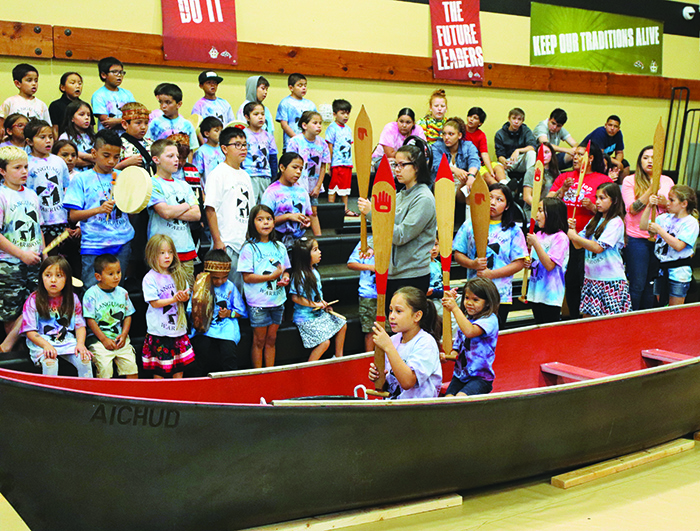
By Micheal Rios, Tulalip News
School is out for summer, but traditional teachings never stop in Tulalip. For the twenty-fourth consecutive year the committed Lushootseed staff, affectionately referred to as Language Warriors, organized a week full of fun, learning and interactive cultural lessons for community youth.
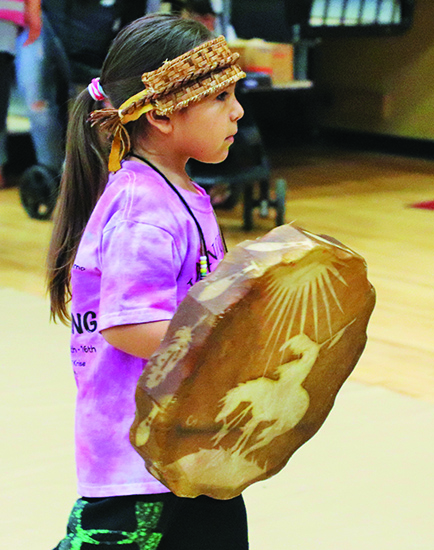
During the 5-day stretch of July 8-12, the Pacific Northwest was pleasantly warm with the occasional overcast. Inside Don Hatch Youth Center the real radiating beams of sunshine could be found, created by 60 inspiring kids participating in week one of the 24th Annual Lushootseed Day Camp.
Open to children age five to twelve with a desire to learn about their traditional lifeways and language of their ancestors, Lushootseed Camp provides invaluable cultural teachings through art, songs, technology, weaving and storytelling. Each year the Lushootseed Department teams up with a select number of vital community volunteers and culture bearers to hold two, one-week day camps in the summer.
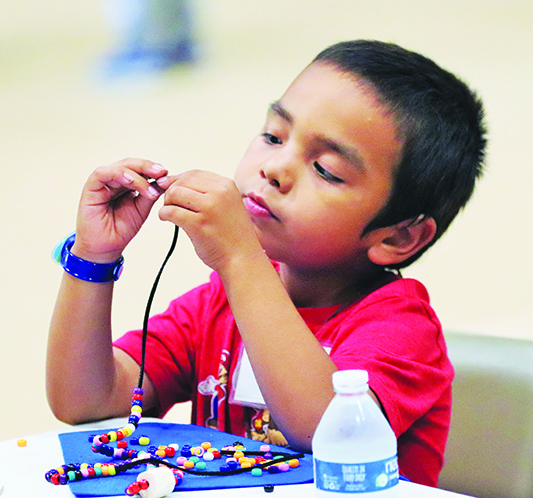
“Our department gathered clams, harvested Devils Club and cedar bark just before camp started to help us all in experiencing the valuable lessons we wanted to pass on to the youth in various activities,” explained Lushootseed Teacher Natosha Gobin. “Originally we wanted to get the youth out in the lands where their ancestors gathered, but were unable to because of transportation costs as well as tides, but we did arrange for them to harvest marsh tea with the assistance of our Natural Resources colleagues.”
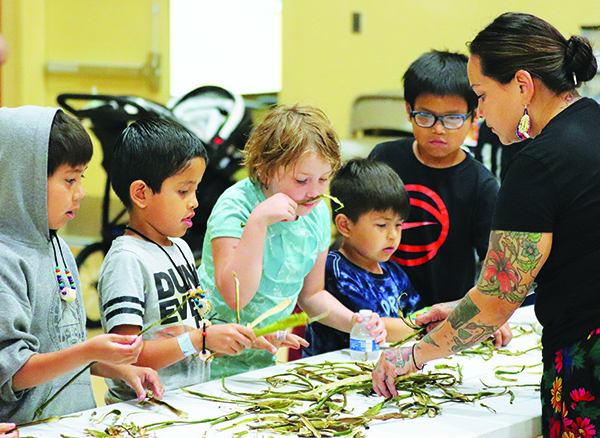
With the impressive turnout in camp participation came an equally impressive turnout in teenaged helpers to assist Lushootseed staff coordinate daily camp activities. There were 10+ summer youth workers, most who had been day camp participants themselves as kids, filling the role of group leaders.
Throughout the weeklong camp, youth participated in a variety of daily stations or activities. The following list is what each child accomplished on a near daily basis:
- Art – Tie-dye camp shirts, dreamcatchers, clam shells, Devil’s Club necklaces.
- Weaving – Cedar mat, Language Warrior necklace.
- Songs and Dances – Clamming Song, Berry Picking Song, Welcome Song, Kenny Moses Arrival Song.
- Traditional Teachings – Smudging, harvesting Devil’s Club, making Devil’s Club salve.
- Games – Various outdoor games incorporating Lushootseed, fishing and clamming concepts.
- Language – Lushootseed alphabet and clamming terms.
- Technology – Children learned and practiced Lushootseed materials using handheld games, stories and videos on Tablets.
- Play – Lizzie’s Clam Digging.
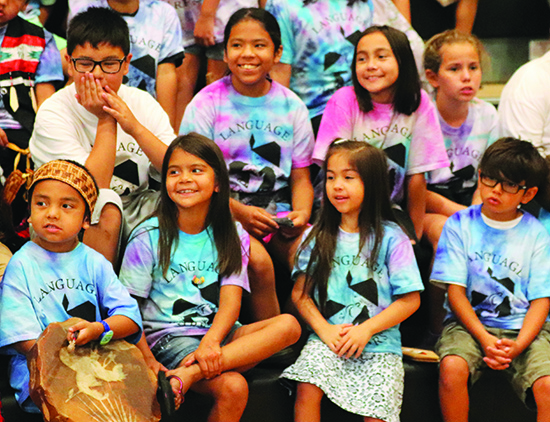
Every station and daily lesson incorporated traditional teachings and Lushootseed verbiage. Using creative hands-on activities to keep the energetic youth focused, the Language Warriors made the most of their opportunities to teach the youngsters about tradition. From vibrant art creations to the proper cleaning and care of clam shells to working together as a community to problem solve, camp kids were learning while having fun.
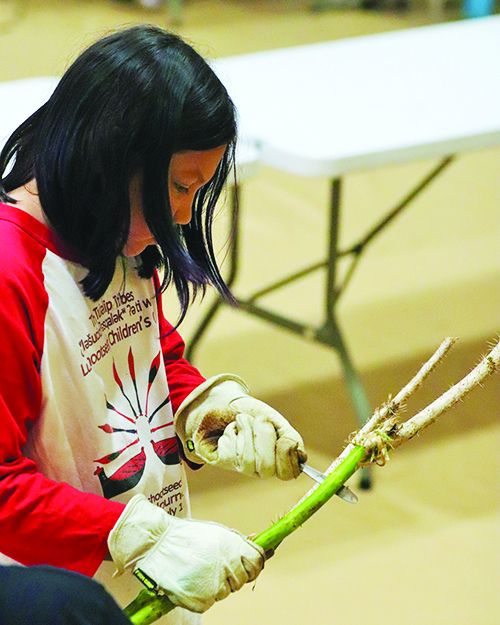
Using tablets loaded with custom built software and the kids’ natural inclination for digital screens, Lushootseed techy Dave Sienko used videos and cartoons to teach tradition.
“To focus on what is being taught specially at this year’s camp we utilized the ACORN (Acquisition Of Restored Native Speech) Language App developed by Southern Oregon University,” said Sienko. “This app allows us to gather the materials the teachers want taught and update it on the fly. I also added several videos that fit with the focus of this year’s camp.
“It’s always amazing to witness how excited some of the students get when they are watching videos to learn about their ancestors, their relationship with nature, and animated traditional stories.”
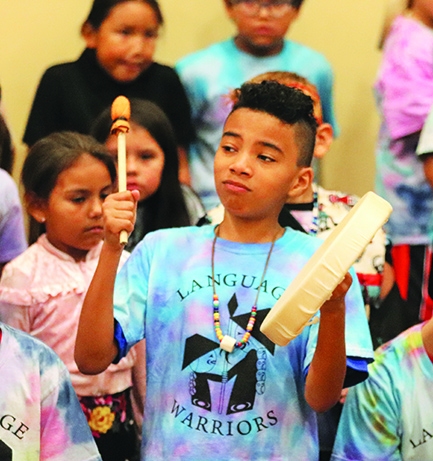
A point of emphasis this year was to teach how Devil’s Club was traditionally used for a wide range of purposes. Several of the activity stations featured Devil’s Club as a fixture for arts and crafts, like necklace or bracelet adornments, or showcased its medicinal purposes.
“Devils Club is a traditional medicine that is culturally, spiritually and physically healing,” shared Natosha as the kids lined up with peaked interest to help harvest the cool named plant. “It’s healing includes aiding in relief of sprains, arthritis, boils, muscle and joint pain, as well as cleansing. Learning how to identify, harvest, process and create medicines with this sacred plant was a recent opportunity enjoyed by us teachers and we’re excited to pass on what we learned.”
The youth witnessed first-hand the transformation of Devil’s Club from its natural form by carefully assisting their teachers to shave off the Devil’s Club bark and process it into a healing salve. Many of the kids couldn’t help themselves and took in big whiffs of the freshly cut plant and its unique fragrance.
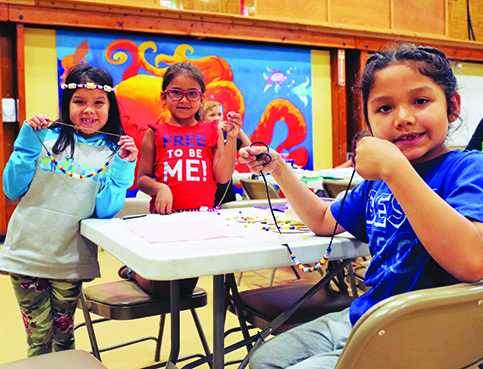
“It smells like a tasty salad!” shouted super excited Rajalion Holland after treating her nose to a few smells of Devil’s Club bark. “Are we really going to use this to make medicine for owies and boo-boos?”
“Yes, we already turned it into medicine…a lot of it,” answered 9-year-old camper Rilla Jones. “We mixed Devil’s Club with melted bees wax and coconut oil, and poured it into tins so the liquid can dry. It becomes a medicine called a salve that heals your skin if you’re hurt.”
For this 24th Annual Lushootseed Camp, Elizabeth “Lizzie” Krise was honored for her leadership and teachings she passed on to the Tulalip community. She’s remembered as one of the key people who helped preserve the Snohomish language. The work she did in the 1960s helped lay a foundation for the current generation of Lushootseed educators to learn, speak and teach their ancestral language. Her story “Lizzie’s Clam Digging” was chosen as the main lesson all teaching stations were built around in a week filled with learning and living a proud Coast Salish culture.
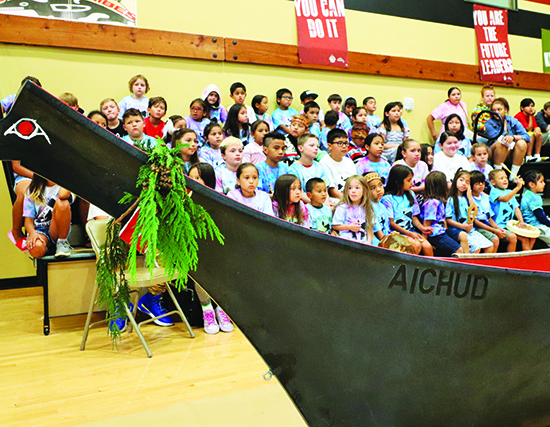
That culture was on full display during the closing ceremony for week one’s camp. Taking place at noon on Friday, July 12, the eager and understandably nervous young play-performers made their stage debut to a community audience of supportive family and friends. Different from previous years, instead of individual kids alternating lines and narration, this particular group performed as one unified voice. They stood up tall and narrated in unison the ten line Lushootseed story, “Lizzie’s Clam Digging.”
Before and after their story rendition, the kids sang and drummed while performing several traditional songs unique to their Tulalip culture. Their sixty minutes of stage time allowed for plenty of reflection and, of course, photo opportunities. “Looking at all these young children here today, I’m very proud each of them for learning our language and keeping it alive,” said Herman Williams Sr. after witnessing the camp’s closing ceremony. “It’s our responsibility to encourage our young ones to build a new walk of life while knowing who they are and remembering where they come from.”
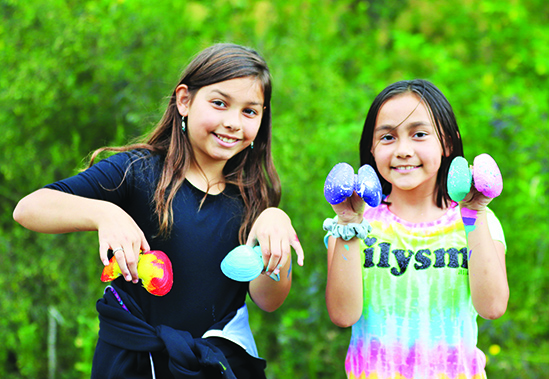
“It was a great honor to witness you all stand up with pride and sing those songs. You all did an amazing job. I got a chill in my body because I felt our ancestors smile,” added ceremonial witness CaryMichael Williams, great-great-grandson of Lizzie Krise.
After the youth’s inspiring performance there was a large giveaway with hundreds of unique items handmade by the campers, including Devil’s Club beaded necklaces and tins of healing salve. Audience members left and right were taken aback by the gifts as they kept coming one after another from their enthusiastic creators. Closing the event was a buffet-style lunch featuring freshly baked Sockeye and an endless bounty of clams.
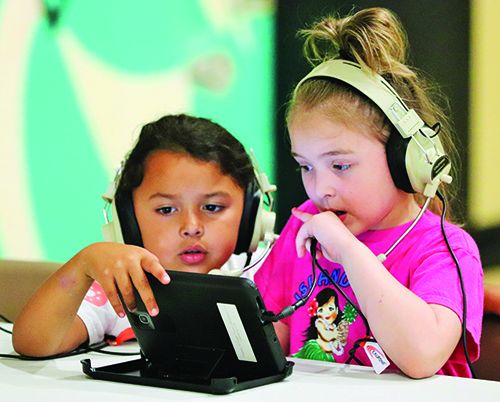
Reflecting back on their week of Lushootseed Camp, two future leaders summed up their experiences and all they learned perfectly. “I liked all the activities and how they each taught us something about our culture,” said 10-year-old Sophia Quimby. “Every single station we’d go to would teach us a Lushootseed word. Having our teachers from school here made it easier to learn.”
“The songs and dances were a lot of fun, too, because I enjoy doing those things,” added 11-year-old Katherine Velasquez. “I enjoyed all the traditional teachings that we got. My favorite parts of the week were doing tie-dye art and learning about Devil’s Club.”
Learning about clam digging, harvesting from nature, creating medicines from traditional plants, creating vibrant cultural items, and learning Lushootseed words that can be used daily were primary goals of this year’s camp. From the sentiments expressed by the youth participants, it’s safe to say those goals were achieved.